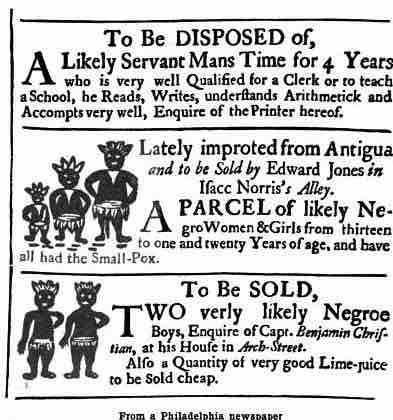Background: Indentured Servitude in the Colonies
In colonial North America, farmers, planters, and shopkeepers found it very difficult to hire workers, primarily because cash was short and it was easy for those workers to set up their own farms. Consequently, the more common solution became to pay the passage of a young worker from the British Isles (including Ireland, Wales, and Scotland) or Germany, who would work for several years to pay off the debt of the travel costs. Tens of thousands of workers, usually Europeans, immigrated as indentured servants (also known as redemptioners), particularly to the 13 colonies of British North America.
An indenture was a legal contract enforced by the courts. Europeans who were displaced from their land or unable to find work signed contracts of indenture and took passage to the Americas. Some indentured servants were deported from their country and sent to the New World as punishment for law breaking. Prior to the American Revolutionary War, an estimated 50,000 convicts from the United Kingdom were transported to the American colonies and served out their time as indentured servants before receiving an official pardon. Labor was in demand in North America, and so free persons were also recruited in exchange for passage to the Americas. Many recruiters abused the system, however, including lying to recruits.
Indentured servitude was a method of increasing the number of colonists, especially in the British colonies. Voluntary migration and convict labor only provided so many people, and because the journey across the Atlantic was dangerous, other means of encouraging settlement were necessary. Contract-laborers became so numerous that the United States Constitution counted them specifically in appointing representatives.
Indenture contract signed with an X by Henry Meyer in 1738
This image illustrates an indenture contract signed with an "X".
Process
Indentured servants or their parents would make arrangements with a ship captain in Europe, who would not charge any money. The captain would transport the indentured servants to the American colonies and sell their legal papers to someone who needed workers. When the ship arrived, the captain would often advertise in a newspaper that indentured servants were for sale. When a buyer was found, the sale would be recorded at the city court. One could buy and sell indentured servants' contracts, and the right to their labor would change hands, but not the person as a piece of property.
In the 17th century, nearly two-thirds of English settlers came as indentured servants. Given the high death rate, many servants did not live to the end of their terms. The servants were not paid wages, but were provided food, room, clothing, and training (also called the "terms of indenture"). Unlike slaves, servants could look forward to a release from bondage. At the end of their term they received a payment known as "freedom dues" and a new suit of clothes; they were then free members of society.

Advertisement
This Philadelphia newspaper advertises the sale of an indentured servant's labor, followed below by advertisements for various slaves. This illustrates the difference between indentured servitude (in which a person's labor is owned) vs. slavery (in which a person is owned).
Abuses of the System
Abuse of indentured servants on board ships is well documented. If a person died more than half way across the Atlantic, the surviving family members had to pay the deceased's fare as well as their own. The crew often pilfered their baggage, and while many travelers started their journey with sufficient funds to pay their way, they were often overcharged so that they arrived with a debt to settle in addition to their servitude contract. If the ship needed to sail before some of the passengers' indentures had been sold, an agent in the American port kept them confined until a buyer presented himself.
Indentures could not marry without the permission of their contract's owner, were subject to physical punishment (occasionally even resulting in death), and saw their obligation to labor enforced by the courts. To ensure uninterrupted work by the female servants, the law lengthened the term of their indenture if they became pregnant.
The British Parliament eventually enacted laws protecting British subjects from the worst abuses. The law required that the specific terms and conditions of servitude be approved by a magistrate in Great Britain and declared that any indentures not bearing a magistrate's seal were unenforceable in the colonies. As a result, colonial masters increasingly sought servants from elsewhere.
Effects on the Economy
Indentured servitude was a major element of colonial labor economics from the 1620s until the American Revolution. The system declined as the price of indentured agricultural labor increased (for example, the cost of indentured labor rose by nearly 60% throughout the 1680s in some colonial regions). Few indentures arrived after 1775, and so southern planters turned increasingly to African slaves for their labor force, who were comparatively less expensive. Thereafter, Africans began to replace indentured servants in both skilled and unskilled positions.